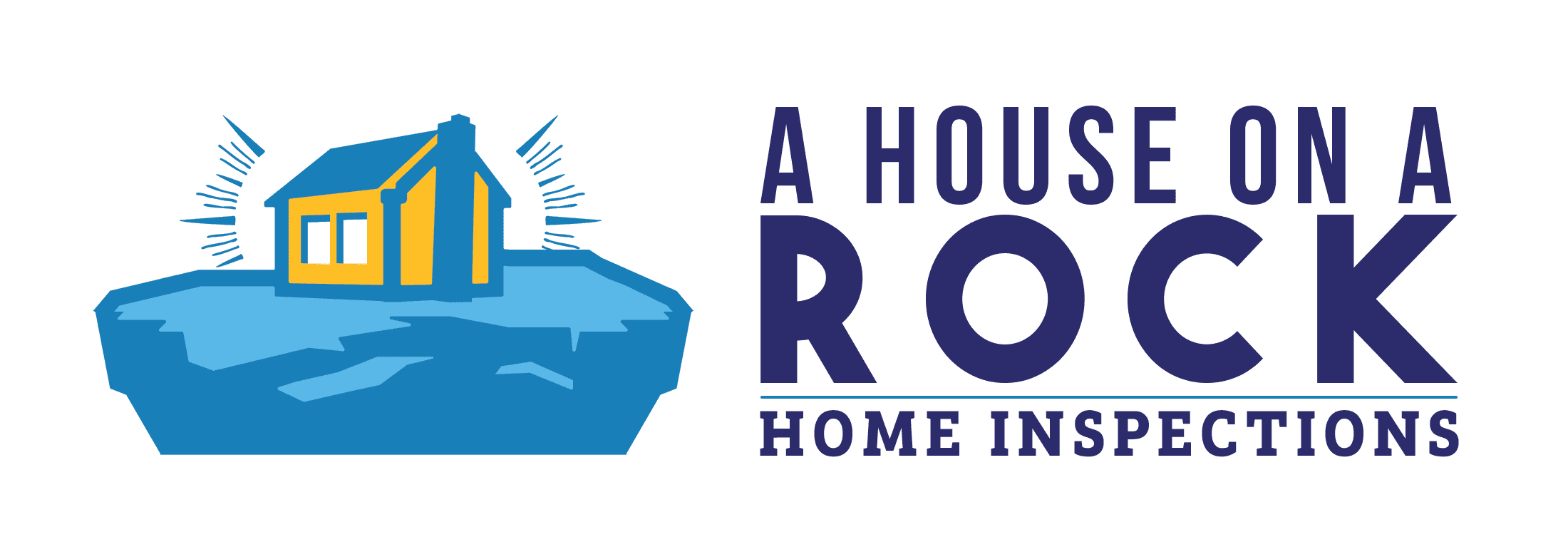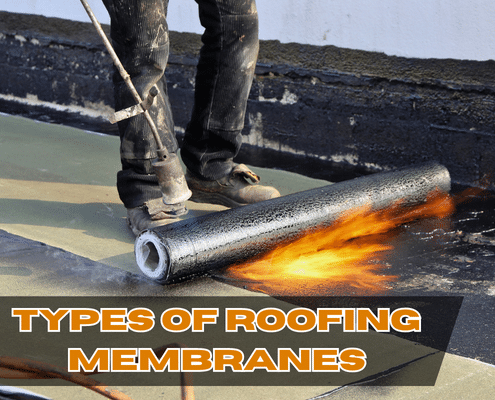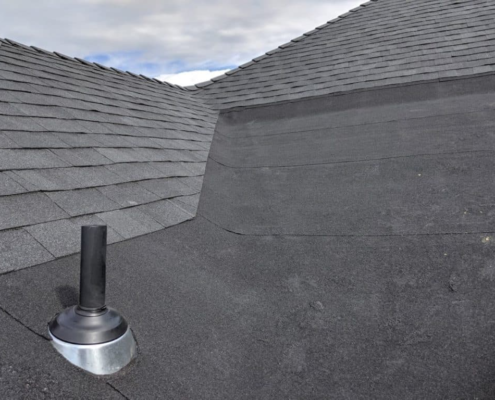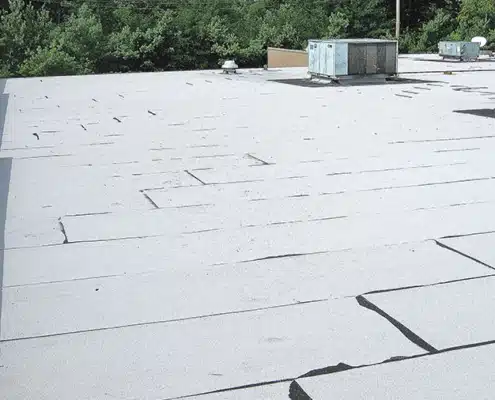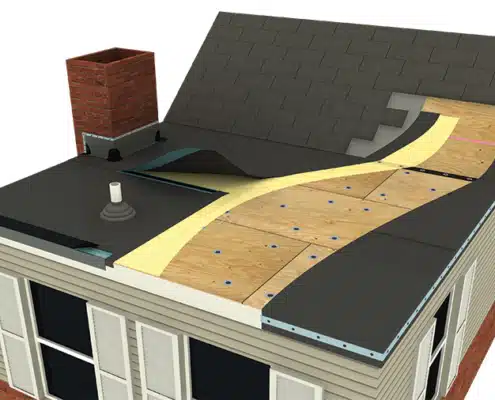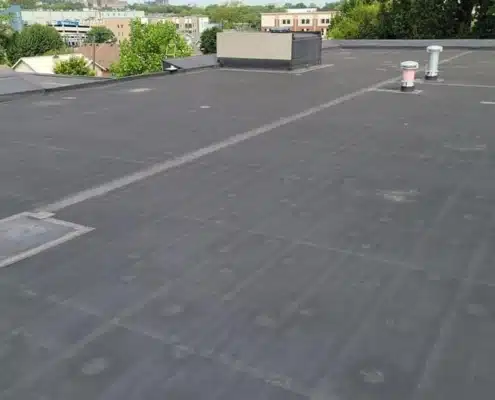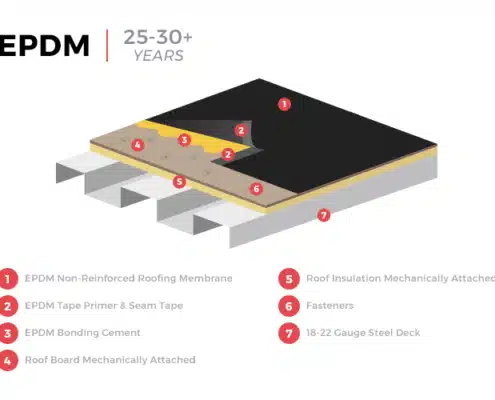Different Types of Single-Ply Roofing Membranes
What is a Roofing Membrane?
Single-ply roofing membranes are roof covering used for low-slope roofs. There a several types of single-ply roofing membranes, such as PVC and EDPM. In addition to residential roofs, you can find them on commercial buildings, RVs, and even pond liners.
Thermoset Vs. Thermoplastic Roofing
There are two main categories of single-ply roofing – thermoset and thermoplastic.
Thermoset membranes are chemically bonded to each other. The result is one large roof membrane instead of a layered membrane.
On the other hand, thermoplastic membranes are not chemically bonded. The seams are heat welded or glued.
The main benefits of thermoset roofs are their high heat resistance and affordability. However, reshaping and recycling are not possible. On the other hand, thermoplastic roofs are impact-resistant, chemical resistant, and recyclable, but they’re more expensive.
What is a Low-Slope Roof?
Low-slope roofs have pitches less than 2:12. In other words, for every 12 horizontal inches, the roof rises 2 vertical inches. Note that low-slope roofs cannot have shingles.
You may hear these roofs called flat roofs or flat roofing systems. However, they are not actually flat.
How to Measure Roof Pitch
Roof pitch refers to a roof’s slope or angle. You can measure roof pitch in several ways, including:
- Use a pitch gauge: A pitch gauge is a tool designed to measure roof slopes. It consists of a level bubble and a protractor. Place the pitch gauge on the roof surface, adjust the bubble to level (between the lines), and read the angle measurement.
- Measuring from the underside: If you have access to the underside of the roof, you can determine the pitch using a level and a tape measure. First, place a level on the underside of the roof. After that, tilt it until it is level. Finally, measure the vertical distance from the level to the roof surface at 12 inches from the edge of the level.
- Using a smartphone app: Several smartphone apps can measure roof pitch by utilizing the device’s built-in sensors.
Types of Single-Ply Roofing Membranes
Modified Bitumen Membranes
Modified bitumen (mod bit) consists of asphalt and rubber or plastic. However, unlike asphalt shingles, you can install them on flat roofs. Like the other single-ply membranes on this list, it is sold in rolls and applied directly to the roof sheathing.
Although rolled roofing and modified bitumen look similar, they differ in composition, durability, longevity, application, and cost.
Pros of Modified Bitumen Roofs
1. Affordability: Modified Bitumen roofs are the cheapest material on this list. At $4-$8 per square foot, it’s one of the market’s most affordable flat roofing materials.
2. Aesthetics: Most single-ply roof membranes are only available in limited colors, such as white and black. On the other hand, mod bit is available in just about any color of asphalt shingles. This makes them one of the best aesthetic choices, and you can buy them to match existing shingles.
3. Flexibility: Although most membrane types are flexible, modified bitumen stays flexible even in freezing temperatures. This prevents it from shrinking, getting brittle, cracking, and leaking.
4. Thickness: Modified bitumen is one of the thickest low-slope roofing materials. For example, EPDM is around 60-80mil, while modified bitumen is around 240mil. This makes mod bit the best option for high foot traffic areas.
Cons of Modified Bitumen Roofs
1. Fire risk: Most roofers seal the seams with a heavy-duty torch. Since most homes are usually made of wood and combustible materials, mod bit roofs are much risker to install.
2. Vulnerable to ponding: Ponding is common on flat roofs, especially in older homes with poor drainage slopes. However, most membrane roofing systems hold up well to ponding. For example, EPDM is a common choice for koi pond liners. On the other hand, modified bitumen roofs are more likely to leak when exposed to ponding.
3. Life expectancy: At 20 years of max life, mod bit roofs have one of the lowest life spans.
EPDM Roofing Membrane
EPDM stands for Ethylene Propylene Diene Monomer, a synthetic rubber type. Its affordability and durability make it a popular choice for “flat” roofs. Plus, it’s also used for pond liners and other sealing applications.
Pros of EPDM Roofing
- Affordability: An EPDM roof system is one of the most affordable flat roofing options. Specifically, it costs $5-$12 per square foot.
- Durability: EPDM roofing is highly durable and can withstand extreme temperatures, UV radiation, and harsh weather conditions. It has a long lifespan of up to 50 years when properly installed and maintained.
- Energy Efficiency: White EPDM roofing is highly reflective, which can help reduce your energy bills by reflecting sunlight and reducing the heat entering your home. However, black EPDM is less energy efficient.
- Easy Installation: EPDM roofing is easy to install and requires fewer tools and equipment than other roofing materials. As a result, this can save you time and money on installation costs.
Cons of EPDM Roofing
- Limited Color Options: EPDM roofing is only available in black and white. This limits your options if you want a specific color to match your home’s exterior.
- Susceptible to Punctures: EPDM roofing is vulnerable to punctures from sharp objects such as tree branches or hail, which can lead to leaks.
- Not Environmentally Friendly: EPDM roofing is not environmentally friendly and contributes to landfill waste when replaced.
Cost of EPDM Roofing
The cost of EPDM roofing can vary depending on several factors, including the size and complexity of your roof, the thickness of the EPDM membrane, and the installation cost. On average, EPDM roofing costs between $5 and $12 per square foot, including installation costs.
TPO Roofing Membrane Systems
TPO ( Thermoplastic Polyolefin) roofing is a single-ply membrane roofing system made from a rubber and plastic blend. They are a more durable and energy-efficient alternative to roofing materials like PVC and EPDM.
Pros of TPO Roofing
- Energy Efficiency – A TPO membrane is a highly reflective material that keeps your home cooler in the summer. This means your air conditioning system won’t have to work as hard to maintain a comfortable temperature. Plus, it can save money on your cooling costs. So, this is an excellent choice for sunny climates.
- Durability – TPO roofing is highly resistant to tears, punctures, and impact damage. It’s also resistant to mold, mildew, and algae growth, which can extend the lifespan of your roof.
- Easy Installation – TPO roofing is easy to install, saving you time and money on installation costs.
Cons of TPO Roofing
- Limited Color Options – TPO roofing is available in a limited range of colors, which may not appeal to homeowners looking for a specific aesthetic.
- Susceptible to Scratches – TPO roofing is susceptible to scratches from sharp objects, so it’s important to be careful when walking on the roof or performing maintenance.
- May Require Maintenance – While TPO roofing is generally low-maintenance, it may require periodic cleaning to remove dirt and debris buildup.
Cost of TPO Roofing
The cost of TPO roofing varies depending on your roof’s size and the installation’s complexity. However, you can expect to pay between $10 and $18 per square foot for TPO roofing installation. Although its more expensive than other membrane roofs, its energy efficiency and durability offer more value.
PVC Roofing Membrane Systems
PVC (polyvinyl chloride) roofing is a single-ply membrane roofing system made from a thermoplastic material. It’s designed to be highly durable and resistant to weathering, making it a popular choice for commercial and residential roofing applications. PVC roofing is also highly reflective, which can help reduce energy costs by keeping your home cooler in the summer months.
Pros of PVC Roofing
- Durability – PVC roofing systems are highly durable and can last up to 30 years or more with proper installation and maintenance. It’s also highly resistant to weathering, punctures, and impact damage, which can help extend the lifespan of your roof.
- Energy Efficiency – PVC membranes are highly reflective, which can help reduce energy costs by keeping your home cooler in the summer months. This can lead to significant energy savings over time.
- Low Maintenance – PVC roofing is generally low-maintenance and can be easily cleaned with soap and water. This can help save you time and money on maintenance costs over the lifespan of your roof.
- Fire Resistance – PVC roofing is highly resistant to fire, making it a safe choice for homeowners concerned about fire hazards.
Cons of PVC Roofing
- Cost – PVC roofing is generally more expensive than other roofing materials, making it less accessible for homeowners on a tight budget.
- Limited Color Options – PVC roofing is available in a limited range of colors, which may not appeal to homeowners looking for a specific aesthetic.
- Susceptible to Scratches – PVC roofing is vulnerable to scratches from sharp objects, so it’s important to be careful when walking on the roof or performing maintenance.
Cost of PVC Roofing
The cost of PVC roofing varies depending on your roof’s size and the installation’s complexity. However, on average, you can expect to pay between $7 and $11 per square foot for PVC roofing installation. While this may be more expensive than other roofing materials, it’s essential to consider the long-term benefits of PVC roofing, including its durability and energy efficiency.
KEE Roofing Membrane System
KEE roofing is a type of thermoplastic membrane known for its exceptional durability and resistance to weathering. It’s made from a unique blend of polymer materials, including Ketone Ethylene Ester, which gives it superior performance characteristics. Although it’s primarily used in commercial roofing projects, its use in residential applications is gaining popularity.
Pros of KEE Roofing
- Durability – KEE roofing is highly resistant to weathering, UV radiation, chemicals, and punctures. It has a long service life, often lasting 30 years or more, saving you money on frequent roof replacements.
- Flexibility – KEE roofing is highly flexible, making it ideal for roofs with complex shapes and contours. It can easily conform to irregular roof surfaces, helping to ensure a watertight seal.
- Energy Efficiency – KEE roofing is highly reflective, which can help reduce heat absorption and lower your cooling costs during hot summer months.
- Low Maintenance – KEE roofing requires minimal maintenance, making it a cost-effective option over the long term. In addition, it’s resistant to mold, mildew, and algae growth, reducing the need for frequent cleaning and maintenance.
Cons of KEE Roofing
- Cost – KEE roofing is generally more expensive than other roofing materials, which can be a consideration for homeowners on a budget.
- Installation – KEE roofing requires specialized installation techniques and experienced contractors, which may increase the installation cost.
- Limited Color Options – KEE roofing is available in a limited range of colors, which may not offer as much variety for homeowners looking for specific aesthetic options.
Cost of KEE Roofing
The cost of KEE roofing varies depending on the size and complexity of your roof, as well as the local labor and material costs. On average, you can expect to pay between $8 and $12 per square foot for KEE roofing installation. While this may be higher than other types of single-ply roofing membranes, the durability and performance of KEE roofing can offset the initial cost over its long service life.
Check Out More Expert Roofing Articles
- Roof Replacement Cost Calculator
- What is Roof Flashing? – Code, Purpose, and Types
- Year 11 of your “20 Year Roof”
- Can a Roof Have Two Layers of Shingles?
- What is Roofing Felt?
- Rafters VS Roof Trusses: Complete Structural Guide
- Top 5 Roofing Materials in Virginia
- 3-Tab Shingles Vs. Laminated Shingles (Architectural)
- What is an Ice Dam
Sources
- https://www.archtoolbox.com/flat-roof-membranes/
- https://epdmroofs.org/
- https://www.billraganroofing.com/blog/what-epdm-roofing
- https://www.peakperformanceroofing.com/modified-bitumen-commercial-roofing.php
- https://roofhippie.com/16-pros-cons-modified-bitumen/
- https://staydryroofing.com/complete-guide-to-a-modified-bitumen-roof/
- https://bobbehrendsroofing.com/epdm-roofing/
- https://www.roofkitroofing.com/epdm-rubber/epdm-installation/
- https://www.threetreeroofing.com/projects/des-moines-flat-roof/
